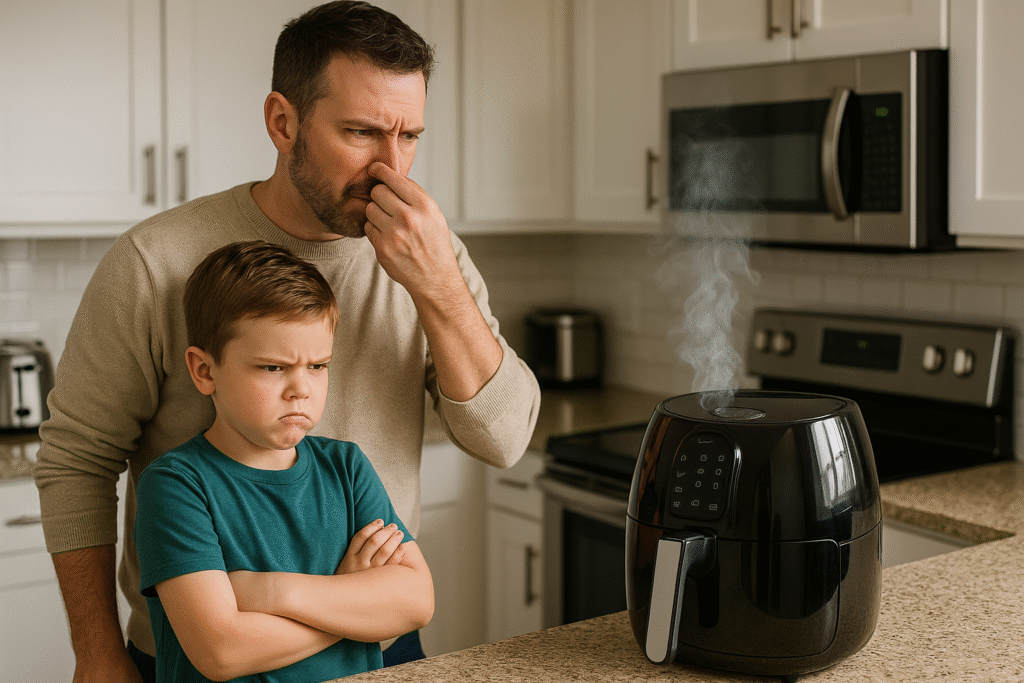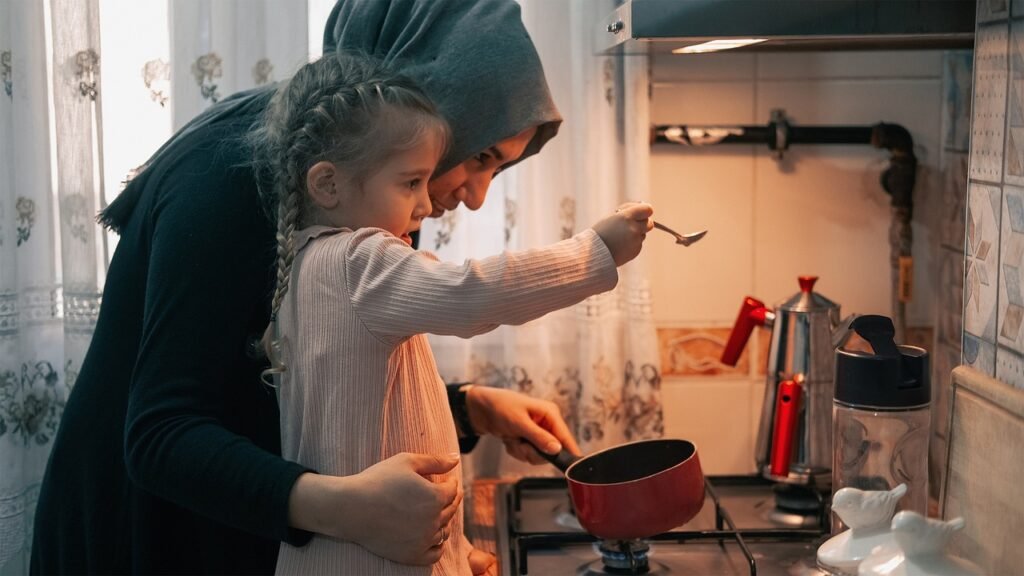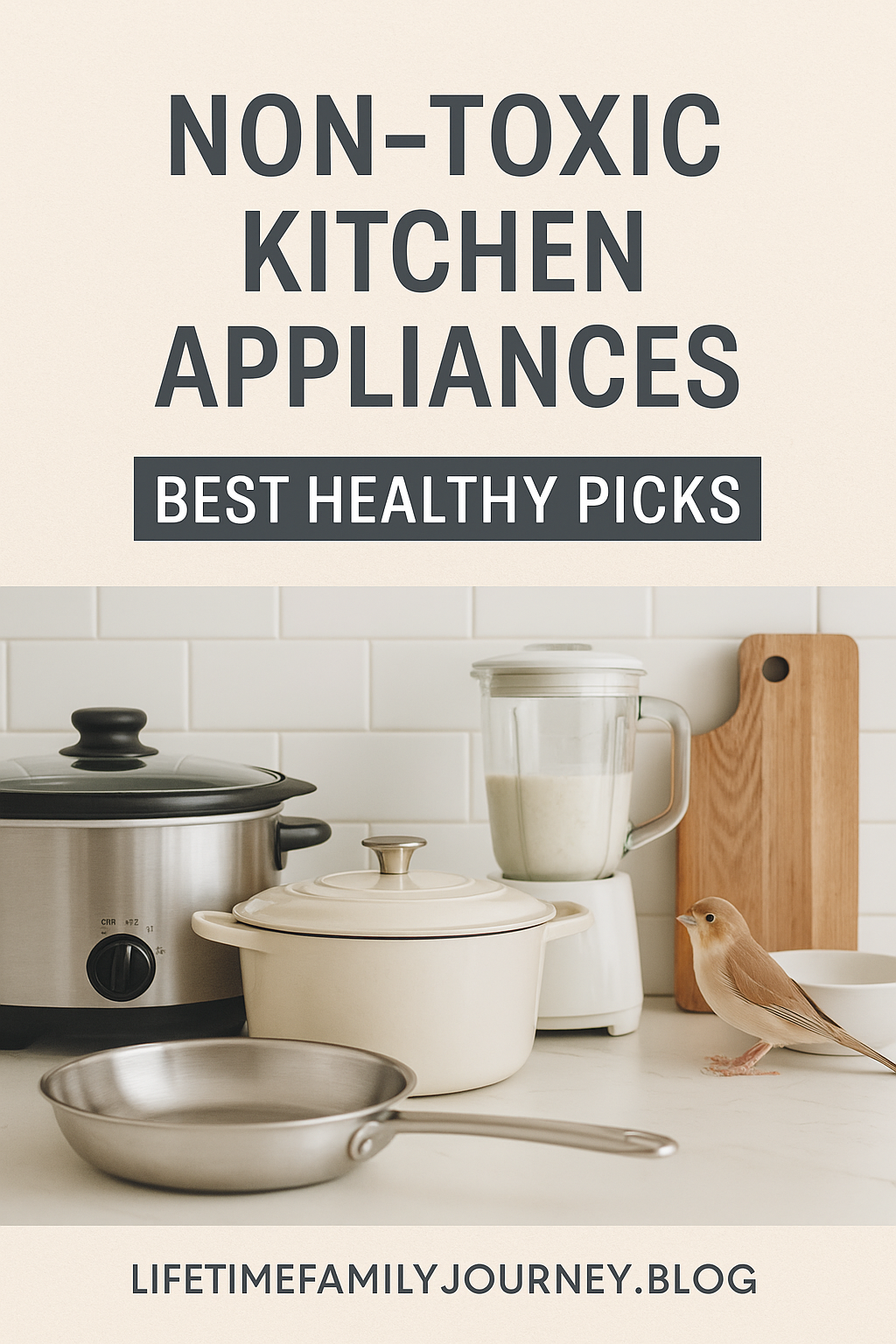Non-Toxic Kitchen Appliances: Best Healthy Picks

I’m prepping dinner for eight people (again), and our trusty air fryer starts releasing this weird chemical smell. My youngest, Brayden, wrinkles his nose and asks, “Dad, why does it smell like markers in here?”
That’s when it hit me. If a six-year-old can smell something funky, what exactly are we breathing in during our daily cooking marathons?
With six kids ranging from Natalie at 20 down to little Brayden, plus our family pets, our kitchen sees more action than a short-order diner. We’re constantly cooking, reheating, and cleaning up after meals. What I didn’t realize until recently was that many of our “convenient” kitchen appliances were quietly exposing my family to toxins every single day.
If you’re juggling a big family like ours, or even if you just want to create a safer cooking environment for your loved ones (including your furry and feathered friends), this guide will show you how to choose non-toxic kitchen appliances that actually protect your family’s health.
Why a Non-Toxic Kitchen Actually Matters (More Than I Initially Thought)
Look, I’ll be honest – I used to roll my eyes at the whole “chemical-free” movement. I’m a former Air Force guy who worked on aircraft hydraulics for 12 years. I’ve been around plenty of chemicals and figured a little Teflon never hurt anybody.
Then our pediatrician mentioned something interesting during Gabrielle’s 13-year-old checkup. Kids’ bodies process toxins differently than adults. Their organs are still developing, and they’re more vulnerable to the effects of daily chemical exposure. Suddenly, all those quick dinners cooked in non-stick pans didn’t seem so harmless.
Here’s what really opened my eyes:
→ Children absorb toxins faster – Their smaller body size means higher concentrations of chemicals relative to their weight
→ Pets are even more sensitive – Especially birds, which can literally die from Teflon fumes (yes, really)
→ Daily exposure adds up – We’re not talking about one-time incidents, but chronic, low-level exposure that builds over time
The EPA’s Safer Choice program has tons of research on this stuff, and frankly, it’s eye-opening when you realize how much we expose ourselves to during everyday cooking.
Our family learned this lesson the hard way when we had to rush our neighbor’s parrot to the emergency vet after using a new non-stick pan. The bird survived, but it was a wake-up call that made us completely rethink our kitchen setup.
Common Kitchen Toxins Hiding in Plain Sight
After doing my homework (and trust me, my wife the math teacher made sure it was thorough), I discovered our kitchen was basically a chemistry experiment gone wrong. Here are the main culprits lurking in most family kitchens:
PTFE (Teflon) – The Silent Killer 🚨
This is the coating on most non-stick cookware. When heated above 500°F (which happens easier than you’d think), it releases fumes that can cause flu-like symptoms in humans and kill birds instantly. Not exactly what you want floating around during Sunday breakfast prep.
(Full disclosure: I definitely overheated plenty of pans before learning this. Don’t ask about the time I left scrambled eggs on high heat and cleared out half the house with the smell.)
PFOA (The Sneaky Leftover)
Technically phased out of manufacturing, but still hanging around in older cookware like that “vintage” non-stick set your mother-in-law gave you for your wedding. It’s been linked to various health issues, and honestly, why risk it?
BPA Plastics
Found in food storage containers, some appliance parts, and can linings. It’s an endocrine disruptor, which means it messes with hormones – especially concerning when you’ve got teenagers already dealing with enough hormonal chaos.
Aluminum Exposure
Cheap aluminum cookware can leach into acidic foods. While the research is mixed, I figure there are enough safer alternatives that there’s no reason to chance it.
Flame Retardants & Mystery Coatings
Some small appliances contain these in their housing or internal components. The Environmental Working Group has documented how these can build up in household dust and get into our systems over time.
Quick Reality Check: I’m not trying to scare anyone into throwing out their entire kitchen (trust me, we can’t afford that anyway). But knowing what to look for helps you make better choices when it’s time to replace things.

Safer Cookware That Actually Works for Big Families
After testing various options with our crew, here’s what actually holds up to daily use while keeping everyone safer:
Ceramic-Coated Cookware ✨
Pros: Easy cleanup, pretty colors that don’t show every scratch
Cons: Can chip if you’re not careful (ask me how I know)
Family Reality Check: Works great until someone decides to use a metal spatula. Choose quality brands – the cheap stuff chips faster than you can say “dinner’s ready.”
Cast Iron & Enameled Cast Iron 💪
Pros: Lasts forever, naturally non-stick when seasoned, perfect for large batches
Cons: Heavy (Melody learned this trying to move my 12-inch skillet)
Dad Tip: Start with one good piece and build from there. My cast iron Dutch oven has fed this family for 15 years and shows no signs of quitting.
Stainless Steel 🏆
Pros: Durable, dishwasher safe, no mysterious coatings
Cons: Learning curve for preventing sticking
Reality: Once you get the hang of proper preheating, it’s actually easier than non-stick for big family meals.
Glass Bakeware
Pros: See your food cooking, completely non-reactive
Cons: Can shatter if temperature shocked
Family Tested: Perfect for casseroles that feed eight people. Just don’t let the teenagers put it straight from oven to sink (learned that one the expensive way).
“When Your Cast Iron Pan Outlives Your Marriage” Durability Chart: (Note: This chart was literally drawn on the back of a grocery receipt after I calculated how many non-stick pans we’ve thrown away, but you get the idea)
| Cookware Type | Expected Lifespan | Family Reality | Cost Per Year |
|---|---|---|---|
| Non-stick | 1-3 years | “Why is everything sticking now?” | $25-50 |
| Cast Iron | 100+ years | Still using great-grandma’s skillet | $0.50 |
| Stainless Steel | 20-30 years | Looks beat up but works perfectly | $3-5 |
| Ceramic | 5-10 years | Pretty until first chip | $8-15 |
Visual Toxin Risk Assessment 🚨
HIGH RISK ████████████ (Old non-stick, overheated Teflon)
MEDIUM RISK ██████░░░░░░ (Cheap aluminum, plastic storage)
LOW RISK ███░░░░░░░░░ (Quality ceramic, some stainless steel)
MINIMAL RISK █░░░░░░░░░░░ (Cast iron, glass, quality stainless)
My Kitchen Upgrade Timeline ⏰
Month 1: 🍳 Replaced main skillet (cast iron)
Month 3: ☕ New coffee maker (glass carafe)
Month 6: 🥘 Slow cooker upgrade (ceramic insert)
Month 9: 🍪 Baking sheets (stainless steel)
Month 12: 📦 Food storage (glass containers)
Month 15: 🔥 Air fryer (stainless interior)
Month 18: 🎉 Finally stopped buying replacement pans!
Safer Small Appliances for Big Families
Here’s where I had to get practical. With six kids and two adults, we need appliances that can handle volume without poisoning us. After research and real-world testing, here are the winners:
Air Fryers That Won’t Gas You Out 🍟
Avoid: Anything with non-stick baskets (most of them)
Choose: Models with stainless steel interiors like the Cuisinart TOA-65
Family Test: We upgraded to a dual-basket model with ceramic coating. Game-changer for cooking different foods simultaneously without the chemical smell.
Slow Cookers & Pressure Cookers 🥘
Look for: Ceramic or stainless steel inserts
Avoid: Teflon-coated models (yes, they exist)
Dad Win: Our 8-quart ceramic slow cooker has been the MVP for feeding this crowd. Throw in ingredients, come home to dinner that doesn’t taste like chemicals.
Coffee Makers (Because Survival) ☕
Priority: Stainless steel and glass components
Skip: Plastic parts that touch hot water
Reality Check: Good coffee is non-negotiable in a house with teenagers and a middle school teacher. We invested in a model with a glass carafe and stainless steel heating element.
Blenders & Food Processors 🥤
Upgrade: BPA-free or glass containers
Why: Plastic can leach chemicals, especially when processing hot foods
Family Hack: Glass blender jars are heavier but don’t retain odors or stains like plastic.
Non-Toxic Kitchen Appliance Shopping List ✅
✓ Air fryer with stainless steel basket
✓ Ceramic slow cooker insert
✓ Glass-carafe coffee maker
✓ BPA-free blender container
✓ Stainless steel toaster oven trays
✓ Cast iron or ceramic cookware
✓ Glass food storage containers
According to Consumer Reports, investing in quality non-toxic kitchen appliances can significantly reduce your family’s daily chemical exposure while often lasting longer than cheaper alternatives.
Pet-Safe Kitchen Considerations 🐦🐶🐱
This section hits close to home because we learned about pet safety the hard way through our neighbors’ near-disaster. If you have pets, especially birds, this isn’t optional – it’s life or death.
Birds: Zero Tolerance Policy
The Reality: Even one-time exposure to overheated Teflon can kill a bird instantly. Their respiratory systems are incredibly sensitive.
Our Solution: No PTFE anything in our kitchen. When friends with birds visit, we double-check everything.
Safety Tip: If you have birds, keep them in a different part of the house during cooking, even with safer appliances.
Dogs & Cats: Floor-Level Concerns
Think Low: Pets live at floor level where chemical particles settle
Food Bowls: Stainless steel or ceramic only – plastic can harbor bacteria and chemicals
Cleaning Products: What you use to clean floors matters since pets lick everything
(Pro tip from living with six kids and pets: if it’s not safe for a toddler to lick, it’s probably not great for your dog either.)
The VCA Animal Hospitals have excellent resources on PTFE toxicity in birds if you want the full scientific breakdown.
Transitioning Without Breaking the Bank (Dad-Budget Approved)
Look, I get it. We’re not made of money, and replacing an entire kitchen’s worth of appliances isn’t happening overnight. Here’s how we made the switch without eating ramen for six months:
Priority Replacement Strategy 💰
Phase 1: Daily-use cookware (the pan you use every morning)
Phase 2: Small appliances that run hot frequently
Phase 3: Specialty items and storage containers
Phase 4: Everything else when budget allows
Money-Saving Tactics That Actually Work
→ Thrift stores and estate sales – Found amazing cast iron pieces for under $20
→ Buy once, cry once – Quality pieces that last decades vs. replacing cheap stuff yearly
→ Seasonal sales – Black Friday deals on stainless steel sets
→ Facebook Marketplace – Gently used ceramic cookware from people jumping on trends
DIY Upgrades
Silicone baking mats instead of parchment paper or non-stick sheets
Glass mason jars for food storage instead of plastic containers
Parchment paper liners in existing pans while saving for upgrades
Budget Reality Check: We spread our upgrades over 18 months and probably spent what we would have on replacing cheap stuff multiple times anyway.
Need more family-friendly kitchen ideas? Check out our family food adventure post for tips on managing cooking chaos with safer equipment.
Cleaning & Maintenance for Longevity

Here’s something they don’t tell you in those fancy cooking blogs: the best non-toxic kitchen appliances in the world won’t help if you’re cleaning them with harsh chemicals that break down their safe coatings.
Natural Cleaning Methods That Actually Work
Baking Soda + Vinegar: The classic combo still works for most cleanup jobs
Salt Scrub: Perfect for cast iron maintenance
Lemon + Salt: Removes stains from cutting boards and brightens stainless steel
Steam Cleaning: For appliance interiors without chemical residue
What NOT to Use
Avoid: Harsh degreasers that can break down ceramic coatings
Skip: Abrasive cleaners on stainless steel (they scratch and create bacteria hiding spots)
Never: Steel wool on anything with a protective coating
(Personal confession: I definitely used steel wool on our first ceramic pan. It lasted about three weeks after that brilliant move.)
Maintenance Schedule That Works
Daily: Quick wipe-down after use, proper drying
Weekly: Deep clean with natural products
Monthly: Check for wear, chips, or coating damage Seasonally: Re-season cast iron, replace worn silicone items
For more detailed cleaning tips that won’t poison your family, check out our guide on safe cleaning products.
The folks at Going Zero Waste have fantastic practical tips for eco-friendly kitchen maintenance that align perfectly with keeping your safer appliances in top condition.
Kitchen Upgrades That Support Long-Term Health
Once you’ve tackled the obvious toxin sources, these upgrades take your family’s health game to the next level:
Water Filtration 💧
Why: Better cooking water means better-tasting food and fewer contaminants
Options: Pitcher filters for budget-conscious families, under-sink systems for serious upgrades Family Impact: Even our pickiest eaters noticed the difference in pasta water taste
Proper Ventilation 🌬️
Reality Check: Even safer cookware produces cooking fumes
Solutions: Range hood, window fans, or just opening windows during cooking
Bonus: Reduces humidity and cooking odors (important with teenagers around)
Smart Storage Solutions
Glass Containers: Replace plastic food storage gradually
Stainless Steel: Perfect for dry goods and leftovers
Silicone: Heat-safe for freezer-to-oven transitions
Storage Conversion Timeline:
- Week 1: Replace most-used plastic containers
- Month 1: Swap lunch containers and leftover storage
- Month 3: Complete pantry storage makeover
- Month 6: Celebrate your plastic-free kitchen victory! 🎉
Lighting Improvements
Full-Spectrum Bulbs: Better visibility means safer food prep
Under-Cabinet Lighting: Reduces shadows and eye strain during cooking marathons
Creating a Family & Pet-Safe Kitchen Culture
The best non-toxic kitchen appliances in the world won’t help if your family doesn’t understand why the changes matter. Here’s how we got everyone on board:
Getting Kids Involved 👨👩👧👦
Age-Appropriate Education:
- Little ones (like Brayden): “This pan is safer for our family”
- Tweens (Gabrielle): Explain basic chemical safety concepts
- Teens (Kaelyn, Melody): Full science behind the decisions
Homeschool Connection: We turned appliance research into a chemistry lesson. The older kids compared studies and learned about toxicology basics.
Kitchen Helpers: Each kid has learned to identify our “safe” vs. “questionable” appliances and cookware.
House Rules That Stick
Posted List: Simple guide on the pantry door showing what’s OK to use
Temperature Awareness: Everyone knows not to overheat pans (even the safer ones)
Pet Safety: Clear guidelines about keeping birds away during any cooking
Making It Fun, Not Scary
“Upgrade Days”: We celebrate each new safer appliance like a mini holiday
Before/After Photos: Kids document our kitchen transformation
Taste Tests: Proving that safer cooking can taste even better
Family Motto: “When your cast iron pan outlives your refrigerator, you know you made the right choice.” (And yes, this has actually happened in our house twice now.)
Family Acceptance Rate of Kitchen Changes:
| Change | Initial Reaction | 6 Months Later |
|---|---|---|
| Cast Iron Cooking | “It’s too heavy!” | “Can we get another one?” |
| Glass Storage | “Why can’t I microwave this?” | “This keeps food fresh longer” |
| Stainless Steel | “Everything sticks!” | “Once you learn the trick, it’s easy” |
| Ceramic Cookware | “Pretty colors!” | “Pretty colors that still work!” |
Translation: Two kids loved the changes immediately, two needed convincing, and two are still suspicious of anything that looks different from what their friends use.
The Real-World Results: What Changed for Our Family
After 18 months of gradually switching to non-toxic kitchen appliances, here’s what we actually noticed (beyond feeling good about our choices):
Health Improvements We Didn’t Expect
Fewer “mystery headaches” during long cooking sessions – turns out, those fumes were affecting us more than we realized
Better air quality overall in the kitchen area
Pets seem more comfortable hanging around during meal prep
Practical Benefits
Longer-lasting equipment – Our cast iron and stainless steel pieces show no signs of wearing out
Better food taste – Especially noticeable with eggs and delicate proteins
Easier maintenance – No more worrying about scratching coatings or replacing pans annually
Financial Impact
Higher upfront costs but lower replacement frequency
Estimated savings over 5 years: approximately $400 by not replacing cheap non-stick pans constantly
Hidden benefit: Teaching kids about quality investments vs. disposable mentality
Family Dynamics
Increased cooking confidence – No more second-guessing whether we’re poisoning dinner
Better kitchen habits – Everyone’s more mindful about proper use and care
Educational value – Kids understand the connection between environment and health
Our Kitchen Transformation by the Numbers:
📊 Appliances Replaced: 12 items over 18 months 💰
Total Investment: $1,200 (spread over time) ⏰
Time to See Results: 3-6 months 😊
Family Satisfaction Rate: 85% (teenager approval is never 100%) 🐕
Pet Stress Reduction: Noticeable improvement in our nervous rescue dog
Troubleshooting Common Concerns

Let me address the questions I get most often from other parents considering this switch:
“Is This Just Expensive Fear-Mongering?”
Fair question. I’m a practical dad, not a conspiracy theorist. The research from legitimate sources like the EPA and Consumer Reports convinced me that minimizing chemical exposure makes sense, especially for kids. Plus, many safer options actually save money long-term.
“My Kids Are Picky Eaters Already – Will Different Cookware Make It Worse?”
Actually, we found the opposite. Food cooked in cast iron and stainless steel often tastes better once you learn proper technique. Our pickiest eaters (looking at you, Melody) didn’t even notice the difference.
“I Don’t Have Time for Complicated Maintenance”
Neither do I. That’s why I focused on truly low-maintenance options. Properly seasoned cast iron is actually easier than constantly replacing scratched non-stick pans. Stainless steel goes in the dishwasher. Glass containers don’t stain or retain odors.
“What If I Can’t Afford to Replace Everything?”
Start with one item – probably your most-used pan or your coffee maker. We spread changes over 18 months and prioritized based on daily use and safety concerns. Every small step helps.
“Are These Changes Actually Necessary?”
Here’s my take: I spent 12 years in the Air Force working with aircraft systems. When it comes to safety, you don’t wait for absolute proof of danger – you minimize risk when reasonable alternatives exist. With kids and pets, I’d rather be cautious with an upside (better-lasting cookware) than sorry later.
Making Your First Smart Swap This Week
Ready to start but feeling overwhelmed? Here’s your simple action plan:
Week 1: Assessment 🔍
Walk through your kitchen and identify:
- Your most-used cookware piece
- Any appliances that smell funny when heated
- Items showing wear, scratches, or coating damage
Week 2: Research & Budget 💰
- Set a realistic budget for first replacement
- Read reviews for specific items
- Check local thrift stores for cast iron or stainless steel finds
Week 3: Make Your First Purchase 🛒
Best First Swaps:
- Daily-use skillet → Cast iron or stainless steel
- Coffee maker → Glass carafe model
- Food storage → Glass containers
- Baking sheets → Stainless steel with silicone mats
Week 4: Test & Learn 🧪
- Practice proper preheating techniques
- Learn maintenance routines
- Notice differences in food taste and cooking experience
Pro Dad Tip: Start with ONE item. Master it. Then move to the next. Trying to change everything at once is a recipe for frustration and family mutiny.
Your “Get Started” Shopping List (Pick ONE):
🥘 Budget Option ($25-40): Lodge cast iron skillet + seasoning oil
☕ Daily Impact ($60-100): Glass-carafe coffee maker
🍽️ Storage Solution ($30-50): Set of glass food containers
🍪 Baking Upgrade ($40-60): Stainless steel sheet pans + silicone mats
Remember, this isn’t about perfection – it’s about making better choices when replacement time comes anyway. Even switching one frequently used item makes a difference for your family’s daily chemical exposure.
Conclusion: Small Changes, Big Impact for Family Health

After 18 months of gradually switching to non-toxic kitchen appliances, I can honestly say it’s been one of the better decisions we’ve made for our family’s health. Not just because of the reduced chemical exposure (though that’s important), but because it’s taught us all to think more carefully about the products we bring into our home.
Our kitchen still sees the chaos of feeding eight people daily. We still have burnt dinners, forgotten lunches, and the occasional culinary disaster. But now we’re doing it all with equipment that won’t gas us out or put our pets at risk.
The best part? Most of these changes actually improved our cooking experience. Food tastes better, equipment lasts longer, and cleanup is often easier. The kids have learned valuable lessons about making thoughtful consumer choices, and even our pickiest eaters haven’t complained about the transition.
Your homework for this week: Pick ONE item from your kitchen that’s showing wear or that you use daily. Research a safer replacement. You don’t have to buy anything yet – just start learning what better options exist.
Whether you replace one pan or completely overhaul your kitchen setup, every step toward reducing your family’s daily chemical exposure is worth celebrating. And who knows? You might discover that safer cooking is actually better cooking.
What’s the first non-toxic kitchen appliance you’re considering for your family? Drop a comment and let me know – I love hearing about other families making these positive changes!
More from Our Family of Blogs:
Lifetime Family Journey – Stories, guides, and lessons from life in a big family.
Mountains Will Move – Faith, resilience, and encouragement for life’s hardest battles.
Everyday Exposed – Real talk on culture, media, and the world we’re raising our kids in.

